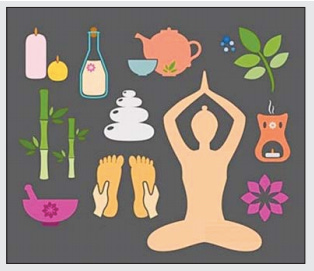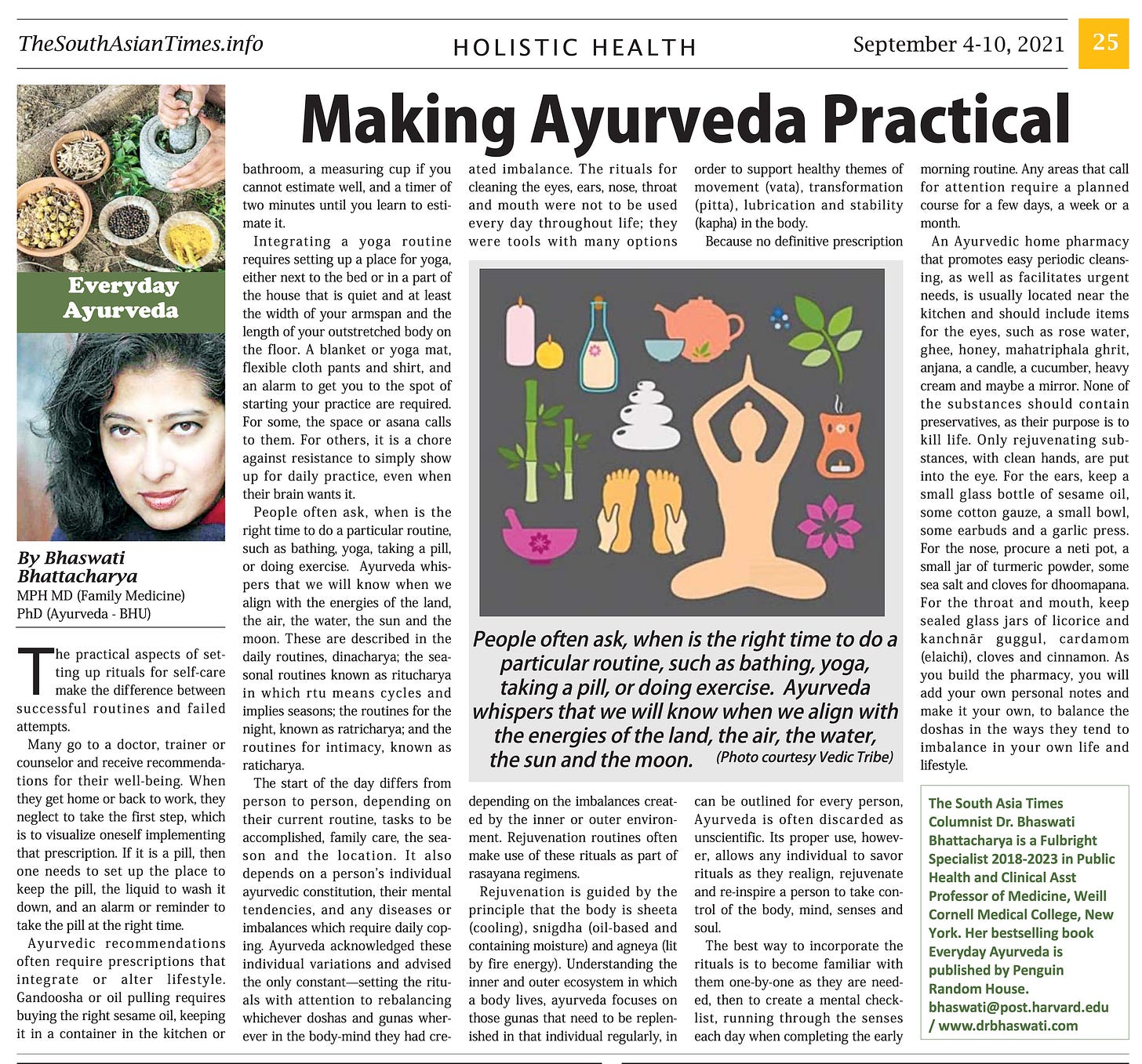Making Ayurveda Practical
The best way to incorporate the cleansing rituals is to become familiar with them one-by-one as they are needed. Because no definitive prescription can be outlined for every person, Āyurveda is often discarded as unscientific. Its proper use, however, allows any individual to savour rituals as they realign, rejuvenate and re-inspire a person to take control of the body, mind, senses and soul. When the clock genes are aligned, the body is revitalized.
How do we make ayurveda practical?
The practical aspects of seting up rituals for self-care make the difference between successful routines and failed attempts.
Many go to a doctor, trainer or counselor and receive recommendations for their well-being. When they get home or back to work, they neglect to take the first step, which is to visualize oneself implementing that prescription. If it is a pill, then one needs to set up the place to keep the pill, the liquid to wash it down, and an alarm or reminder to take the pill at the right time.
Ayurvedic recommendations often require prescriptions that integrate or alter lifestyle. Gandoosha or oil pulling requires buying the right sesame oil, keeping it in a container in the kitchen or bathroom, a measurement cup if you cannot estimate well, and a timer of two minutes until you learn to estimate it.
Integrating a yoga routine requires setting up a place for yoga, either next to the bed or in a part of the house that is quiet and at least the width of your armspan and the length of your outstretched body on the floor. A blanket or yoga mat, flexible cloth pants and shirt, and an alarm to get you to the spot of starting your practice are required. For some, the space or aasana calls to them. For others, it is a chore against resistance to simply show up for daily practice, even when their brain wants it.
People often ask, when is the right time to do a particular routine, such as bathing, yoga, taking a pill, or doing exercise. Ayurveda whispers that we will know when we align with the energies of the land, the air, the water, the sun and the moon. These are described in the daily routines, dinacharya; the seasonal routines known as rtucharya in which rtu means cycles and implies seasons; the routines for the night, known as ratricharya; and the routines for intimacy, known as raticharya.
The start of the day differs from person to person, depending on their current routine, tasks to be accomplished, family care, the season and the location. It also depends on a person’s individual ayurvedic constitution, their mental tendencies, and any diseases or imbalances which require daily coping.
Āyurveda acknowledged these individual variations and advised the only constant—setting the rituals with attention to rebalancing whichever doshas and gunas wherever in the body-mind they had created imbalance. The rituals for cleaning the eyes, ears, nose, throat and mouth were not to be used every day throughout life; they were tools with many options depending on the imbalances created by the inner or outer environment. Rejuvenation routines often make use of these rituals as part of rasayana regimens.
Rejuvenation is guided by the principle that the body is sheeta (cooling), snigdha (oil-based and containing moisture) and agneya (lit by fire energy). Understanding the inner and outer ecosystem in which a body lives, ayurveda focuses on those gunas that need to be replenished in that individual regularly, in order to support healthy themes of movement (vata), transformation (pitta), lubrication and stability (kapha) in the body.
Because no definitive prescription can be outlined for every person, Āyurveda is often discarded as unscientific. Its proper use, however, allows any individual to savour rituals as they realign, rejuvenate and re-inspire a person to take control of the body, mind, senses and soul.
The best way to incorporate the cleansing rituals is to become familiar with them one-by-one as they are needed, then to create a mental checklist, running through the senses each day when completing the early morning routine. Any areas that call for attention require a planned course for a few days, a week or a month.
An Āyurvedic home pharmacy that promotes easy periodic cleansing, as well as facilitates urgent needs, is usually located near the kitchen and should include items for the eyes, such as rose water, ghee, honey, mahatriphala ghrit, anjana, a candle, a cucumber, heavy cream and maybe a mirror. None of the substances should contain preservatives, as their purpose is to kill life. Only rejuvenating substances, with clean hands, are put into the eye. For the ears, keep a small glass bottle of sesame oil, some cotton gauze, a small bowl, some ear buds and a garlic press. For the nose, procure a neti pot, a small jar of turmeric powder, some sea salt and cloves for dhoompana. For the throat and mouth, keep sealed glass jars of licorice and kanchnār guggul, cardamom (elaichi), cloves and cinnamon. As you build the pharmacy, you will add your own personal notes and make it your own, to balance the doshas in the ways they tend to imbalance in your own life and lifestyle.
week 75. TheSouthAsianTimes
Download the .pdf version of this column by clicking on the image.
Dr. Bhaswati Bhattacharya is a Fulbright Specialist 2018‐2023 in Public Health. She serves as Clinical Asst Professor of Family Medicine in the Department of Medicine at Weill Cornell Medical College in New York, NY.
Her bestselling book Everyday Ayurveda is published by Penguin Random House. To order an autographed copy, write to bhaswati@post.harvard.edu.





